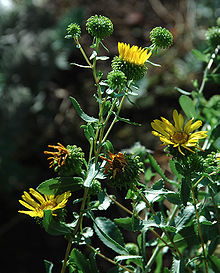Grindelia squarrosa
| Grindelia squarrosa | |
|---|---|

| |
| Curlycup gumweed (Grindelia squarrosa) | |
| Scientific classification | |
| Kingdom: | |
| (unranked): | |
| (unranked): | |
| (unranked): | |
| Order: | |
| Family: | |
| Tribe: | |
| Genus: | |
| Species: | G. squarrosa
|
| Binomial name | |
| Grindelia squarrosa | |
| Synonyms[1] | |
|
Synonymy
| |

Grindelia squarrosa, also known as a curly-top gumweed or curlycup gumweed, is a small North American biennial or short-lived perennial plant.[2]
It is native to western and central North America, from British Columbia east to Québec and New England, and south as far as California, Arizona, Chihuahua, and Texas. The species may possibly be naturalized in much of the eastern part of that distribution.[3][4][5][6]
Description
Grindelia squarrosa is often found in disturbed roadsides, streamsides; 700–2,300 metres (2,300–7,500 ft) in elevation. It is a decumbent to erect, much-branched perennial herb of subshrub up to 100 cm (40 inches) tall. The 1.5–7 cm leaves are gray-green, crenate with each tooth having a yellow bump near its tip, and resinous.[5][7]
Grindelia squarrosaproduces numerous flower heads in open, branching arrays. Each head usually contains 12-40 yellow ray flowers, though sometimes the rays are absent. These surround many small disc flowers. The plant blooms from July through late September.[5][8][7]
Varieties
- Grindelia squarrosa var. quasiperennis [9]
- Grindelia squarrosa var. serrulata [10]
- Grindelia squarrosa var. squarrosa [11]
Uses
Grindelia squarrosa is a notable native pollinators plant in its natural habitats, listed by the Lady Bird Johnson Wildflower Center Native Plant Information Network—NPIN, to be of "Special Value to Native Bees."[6]
The plant concentrates selenium, and can be toxic when ingested by cattle, humans, and other mammals.[5]
Native American medicinal plant
Grindelia squarrosa was used by Great Plains Tribes as a medicinal herb to treat illnesses such as asthma, bronchitis or skin rashes.[6][12][13]
It was used as a traditional medicinal plant by Shoshone peoples in various regions.[12] The Gosiute band dialect's Shoshone language name for the plant is mu’-ha-kûm.[14] The Lakota language name for the plant is pteíčhiyuȟa.
See also
References
- ^ The Plant List, Grindelia squarrosa (Pursh) Dunal
- ^ ITIS Standard Report Page: Grindelia squarrosa
- ^ United States Department of Agriculture plants profile: Grindelia squarrosa
- ^ Biota of North America Program 2014 county distribution map
- ^ a b c d Jepson Manual, University of California (TJM2)
- ^ a b c Lady Bird Johnson Wildflower Center Native Plant Information Network—NPIN, University of Texas: Grindelia squarrosa (Curlycup gumweed)
- ^ a b Flora of North America, Grindelia squarrosa (Pursh) Dunal, 1819.
- ^ Kansas Wildflowers & Grasses
- ^ United States Department of Agriculture plants profile: Grindelia squarrosa var. quasiperennis
- ^ United States Department of Agriculture plants profile: Grindelia squarrosa var. serrulata
- ^ United States Department of Agriculture plants profile: Grindelia squarrosa var. squarrosa
- ^ a b University of Michigan at Dearborn, Native American Ethnobotany Database: Grindelia squarrosa
- ^ Northern Prairie Wildlife Research Center
- ^ Chamberlin, Ralph Vary (1911). "The Ethno-botany of the Gosiute Indians of Utah" (PDF). Memoirs of the American Anthropological Association Vol II, part 5. Retrieved 2007-11-12.
External links
- Grindelia
- Flora of Canada
- Flora of Northeastern Mexico
- Flora of Northwestern Mexico
- Flora of the Eastern United States
- Flora of the Western United States
- Flora of the Great Plains (North America)
- Flora of California
- Flora of the Great Basin
- Flora of the Sierra Nevada (U.S.)
- Plants described in 1813
- Plants and pollinators
- Plants used in traditional Native American medicine
